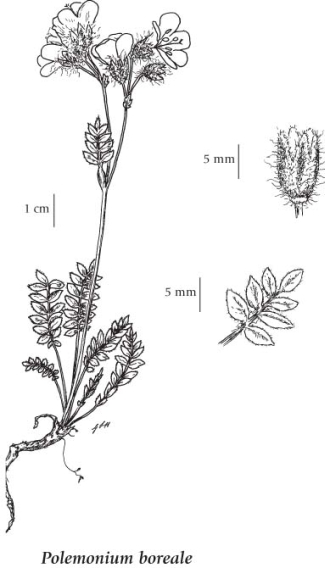Polemonium boreale M.F. Adams
northern Jacob's-ladder
Polemoniaceae (Phlox family)
Introduction to Vascular Plants
northern Jacob's-ladder
Polemoniaceae (Phlox family)
Introduction to Vascular Plants
Species Information
General:
Perennial herb from a rhizome and branching stem-base; stems single or several, loosely tufted, erect or ascending, spreading-hairy to glandular-hairy, 8-30 cm tall.
Leaves:
Alternate, mostly basal, pinnately compound; leaflets 13 to 23, elliptic to oval, 4-12 mm long, 1-5 mm wide, distinctly hairy (at least when young).
Flowers:
Inflorescences terminal or axillary head-like clusters of short-stalked flowers; corollas blue, rarely white, broadly bell-shaped, 15-20 mm long, the 5 lobes slightly longer than the yellowish tube and rounded at the tip; calyces 5-10 mm long, the 5 teeth lanceolate to oblong, usually pointed.
Fruits:
Capsules, 3-chambered.
Illustration

If more than one illustration is available for a species (e.g., separate illustrations were provided for two subspecies) then links to the separate images will be provided below. Note that individual subspecies or varietal illustrations are not always available.
Illustration Source: The Illustrated Flora of British Columbia
Ecology
Ecological Framework for Polemonium boreale
The table below shows the species-specific information calculated from
original data (BEC database) provided by the BC Ministry of Forests and Range.
(Updated August, 2013)
The table below shows the species-specific information calculated from
original data (BEC database) provided by the BC Ministry of Forests and Range.
(Updated August, 2013)
| Site Information |
Value / Class |
||
|
Avg |
Min |
Max |
|
| Elevation
(metres) |
1528 | 780 | 2341 |
| Slope
Gradient (%) |
17 | 0 | 65 |
|
Aspect (degrees) |
314 | 10 | 348 |
| Soil
Moisture Regime (SMR) [0 - very xeric; 4 - mesic; 8 - hydric] |
3 | 1 | 6 |
| Modal
Nutrient Regime
Class |
C | ||
| #
of field plots species was recorded in: |
12 | ||
| Modal
BEC Zone Class |
ESSF | ||
|
All BEC Zones (# of stations/zone) species was recorded in |
BAFA(3), BWBS(2), ESSF(3), IDF(2), SWB(2) | ||
|
Source:
Klinkenberg 2013
|
|||